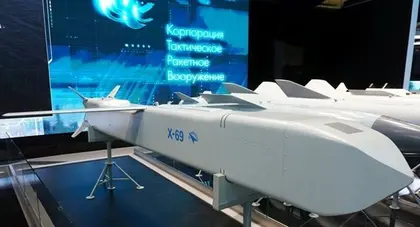In the early hours of Thursday April 11, Russia attacked Ukraine with more than 80 missiles and drones. One of the targets was the Trypillia thermal power plant (TPP), Ukraine's largest, located 50 km south of Kyiv, which was hit and almost completely destroyed after being hit by as many as five Kh-69 missiles.
Kh-69
The Kh-69 (Cyrillic Х-69) is Russia's newest air-launched, sub-sonic cruise missile, intended to engage static, high value targets and is believed to be an upgrade of the earlier KH-59 Mk2, incorporating stealth technology. It first appeared in public in August 2022 at the Russian military forum Armiya-2022 and then in 2023, it was presented at the Dubai Airshow.
JOIN US ON TELEGRAM
Follow our coverage of the war on the @Kyivpost_official.
To many analysts the Kh-69 represents a greater threat to air defense because, although it is not ballistic or hypersonic, and has a smaller warhead than other missiles including the Kh-47М2 Kinzhal, it cruises at 750-1,000 kph at the extremely low altitude of 20 meters. Previous generations of Russian cruise missile, such as the Kh-101 fly at 50-70 meters or higher.
The missile’s low altitude combined with low visibility to radar from the wave-absorbing material that makes up its body makes it difficult to detect, intercept and destroy.
In appearance the Kh-69 resembles the British Storm Shadow, the French SCALP-EG and the German Taurus cruise missiles. The retractable wings and its body shape suggest its designers, the MKB Raduga subsidiary of Russia’s Tactical Missile Corporation, applied many of the design principles of its NATO counterparts.

Shield AI Opens In-Country Office for Operational Support to V-BAT System
Russia claims the Kh-69 was specifically designed for use by its fifth-generation Su-57 fighter bomber and is designed to be carried inside its fuselage. It is also understood to be launched from under wing pylons fitted to the majority of Russian aircraft including: Su-30МК, Su-34, Su-35S, MiG-35S and MiG-29К.
The declared weight of the Kh-69 is around 800-kilograms (1,800 pounds) with a 310-kilogram (680 pounds) warhead and maximum range of approximately 300 kilometers (190 miles), although some sources claim it could be as much as 400 kilometers (250 miles which places a number of important Ukrainian targets, including the capital, within range of the missile.
The guidance system employed by the Kh-69 is the same as that used by the Kh-101, combining GLONASS and GPS satellite positioning, with inertial backup. The designers claim that maximum deviation from the target does not exceed 5 meters.
It should be noted that the only open-source data available on the performance and technical characteristics of the Kh-69are those declared by Russia. The figures for warhead size, range, precision, and other parameters may differ from those as has been seen with other missile systems.
Why did Ukraine fail to defend Trypillia from the Kh-69 missiles?
Russia has been targeting Ukraine’s air defenses for more than two years both in trying to secure complete air superiority and to analyze its strengths and weaknesses.
At the start of the full-scale invasion the focus was on destroying Ukraine's Soviet-era air defense assets. Later, after Ukraine received modern NATO-standard air defense systems, Russia had to learn how to successfully take them on.
Over time they have been able to identify which assets are well-protected and to modify its tactics including the laying of routes that avoided the “hot spots” and made it harder to identify the intended targets and to be intercepted en-route; this has included, on more than one occasion flying through the airspace of neighboring EU and NATO countries to circumvent Ukraine’s defenses.
Russia's continuing systematic missile strikes not only allow it to improve and invent new methods of evading Ukrainian air defenses but also to drain Ukraine’s anti-aircraft and anti-missile stocks which the West supplies in limited amounts and which Ukraine is currently unable to produce.
IT seems likely that in terms of the Trypillia TPP a tipping point was reached and Ukraine’s air defenses around the site simply ran out of missiles. As President Volodymyr Zelensky told PBS news hour in a recent interview:
“Eleven missiles were launched towards the Trypillya station, upon which the electricity supply in the Kyiv region depends. We managed to intercept the first seven, but the remaining four hit Trypillya. Why? Because we had zero missiles left. We have exhausted all the missiles that were defending Trypillya,”
What makes it even more difficult to intercept the Kh-69 is that, unlike the Kh-101 and other cruise missiles that are launched from strategic bombers, it is launched from tactical aircraft, that are less visible on take-off, are faster and more maneuverable and can rapidly change direction and course compared to large bombers.
Perhaps the one saving grace in terms of the Kh-69 is that markings on those missiles used seemed to indicate that they were produced in 2023 and 2024 which, in turn, suggests that the missiles may not yet be in full, serial production as also seen with the recent use of Tsirkon hypersonic missiles which appeared to be prototypes. The threat will become even more acute if and when that is achieved.
It is nevertheless obvious that Russia intends to continue to attack Ukraine’s infrastructure and terrorize its citizens through the use of any and all types of missile. The fate of the Trypillya TPP must signal yet again to Ukraine’s partners of the pressing need to reinforce its air defenses as a matter of urgency.
You can also highlight the text and press Ctrl + Enter










